Expert Q&A: Robbie Bond
By Amy Nelson
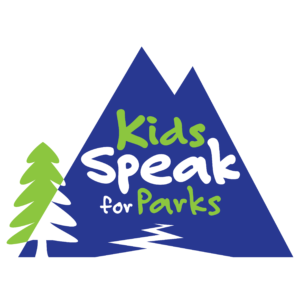 After watching the animated film “The Lorax,” fourth grader Robbie Bond was inspired. Aware of Every Kid in a Park, an initiative launched by President Obama that provides fourth graders and their families with free entry to more than 2,000 federally managed lands and waters, the nature-loving nine-year-old and his mother, Michelle, began planning a trip to visit every national park. In April of this year, however, both the itinerary and intensity of their travel plans changed. That is when President Trump signed an Executive Order directing Interior Secretary Ryan Zinke to review 27 National Monuments that had been designated by Presidents Clinton, Bush, and Obama under the Antiquities Act of 1906.
After watching the animated film “The Lorax,” fourth grader Robbie Bond was inspired. Aware of Every Kid in a Park, an initiative launched by President Obama that provides fourth graders and their families with free entry to more than 2,000 federally managed lands and waters, the nature-loving nine-year-old and his mother, Michelle, began planning a trip to visit every national park. In April of this year, however, both the itinerary and intensity of their travel plans changed. That is when President Trump signed an Executive Order directing Interior Secretary Ryan Zinke to review 27 National Monuments that had been designated by Presidents Clinton, Bush, and Obama under the Antiquities Act of 1906.
 At that moment, Robbie decided to take action. With the intention of building an army of fourth graders who would speak out and stand up for parks, he started a nonprofit organization called Kids Speak for Parks. He then set out to visit the 27 sites under review himself, so he could let people know what was at stake should their designations as National Monuments be rescinded. We caught up with Robbie and his parents just after they had visited the Mojave Trails National Monument in California. You can follow Robbie’s journey by visiting the Kids Speak for Parks Facebook page.
At that moment, Robbie decided to take action. With the intention of building an army of fourth graders who would speak out and stand up for parks, he started a nonprofit organization called Kids Speak for Parks. He then set out to visit the 27 sites under review himself, so he could let people know what was at stake should their designations as National Monuments be rescinded. We caught up with Robbie and his parents just after they had visited the Mojave Trails National Monument in California. You can follow Robbie’s journey by visiting the Kids Speak for Parks Facebook page.
You are visiting all of the 27 national monuments on the Department of the Interior’s review list. How many have you visited so far?
Robbie: I have visited six.
I follow your Facebook page, and I heard you say that so far, Grand Staircase Escalante National Monument has been your favorite. Is that still true? If so, why?
Robbie: Yes. I liked the pictographs and I liked hiking. I also learned about Native American plants that are really important, and I went to a place called Singing Canyon, where there are holes in the walls. The caves are all connected so you can go in one hole and come out another.
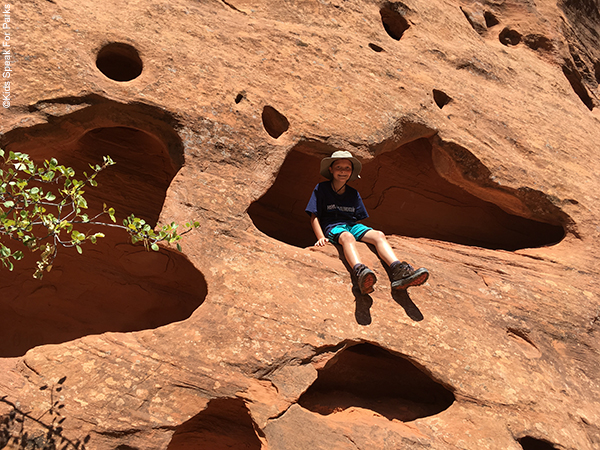
At Bears Ears National Monument, you met a young man named Alejandro Yazzie from the Ute Tribe. What was one of the most important or interesting things that you learned from Alejandro?
Robbie: He told me about his family’s culture, and how his great, great—I forgot how many “greats” it was—granddad actually saw the first white people come there. I knew that there were Native Americans at Bears Ears, but I didn’t know much about them. When I went there, I learned a lot about their culture and how they survived.
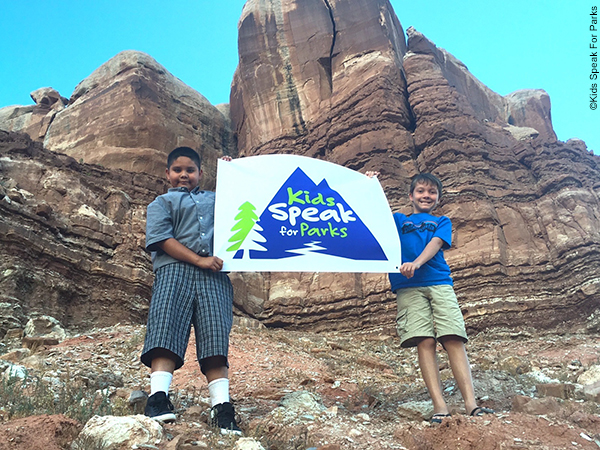
You are calling for an army of 4th graders to “speak for parks.” What do you want this army to say on behalf of our parks and monuments?
Robbie: Don’t give up because if you give up you can’t accomplish anything. Speak up to everyone about how amazing the parks are because a lot of people don’t even know that this is happening. It will take a lot of people telling a lot of people to get everyone to know about it.
How much has your army grown since you started?
Robbie: It has grown a lot. You don’t have to be a fourth grader to get involved.
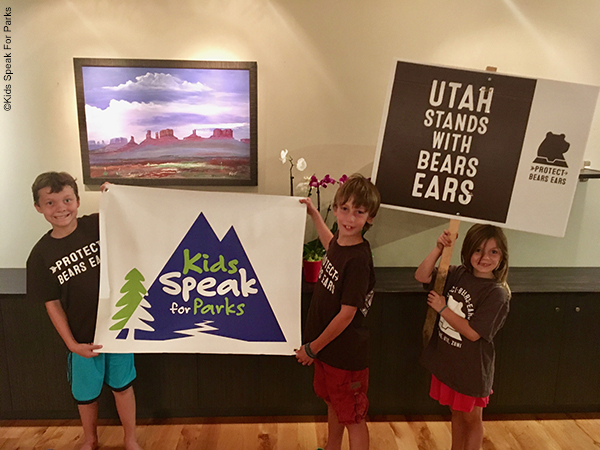
Has anyone ever not taken you seriously because you’re a kid?
Robbie: I don’t like to remember those guys, because they’re not very helpful. I just pretend they don’t exist.
What gives you hope for our parks and other places like them in the world?
Robbie: The amount of people who are still trying to protect our parks, and just seeing how much wilderness there is.
A lot of adults (including many of the people who read this publication) have been working hard to protect and improve all kinds of parks—national parks and monuments, state and city parks, and even small community parks. A lot of them might find it easy to lose hope. What advice do you have for them?
Robbie: Don’t give up. You can always find things that will keep you going, like other people and animals. As a last resort, just watch cute puppy videos on the Internet.
Kids are important users of parks, but I bet they are rarely asked to be involved in the planning and design of parks and in park projects. What do you think would happen if more kids were involved in those kinds of projects?

Robbie: I think it would work way better. Adults can’t always appreciate the things that make the parks fun, like the chipmunks that steal your s’mores. These are a lot of little, tiny things that kids appreciate but adults don’t really notice. Adults will look at the bigger picture, like the amount of trees. Children look at the types of trees, and the types of animals that live there. Adults don’t think about that kind of stuff as much as kids do.
Where did your passion for parks come from?
Robbie: Most of it probably came from my parents. There’s a program in Hawaii, where I live, called GET THE DRIFT AND BAG IT. Every year they have a beach cleanup, and almost every year, we go to it. Every time I go fishing or go to the beach with my family, we always try to protect the environment.
A lot of parents out there—myself included—struggle to compete with the draw of electronic devices. I’d like to ask your parents if they have any advice for other parents who are hoping to instill in their children a sense of wonder and stewardship of nature?
Michelle: We’re a bit biased, because we come from Hawaii, where it is easier to get away from electronics. We can go out and actually rescue a sea turtle, which is way more exciting than Minecraft. But for anyone, going outdoors and creating fun family time helps a lot, even if you’re just going somewhere like a small, local park. It is also helpful when kids can see the impact of their choices, like when they see something like rings from soda cans that get caught around a sea turtle’s neck. Even when they see something like that on a YouTube video, it becomes more real. That helps children develop a passion.
Robin: I’m not a tech-friendly fellow, but there is something to be said for accepting that technology is unavoidable. It is essential to maintain a balance in our children’s lives between technology and the rest of the things in life that are important. But technology is also a tremendous resource for spreading the message and getting people informed.
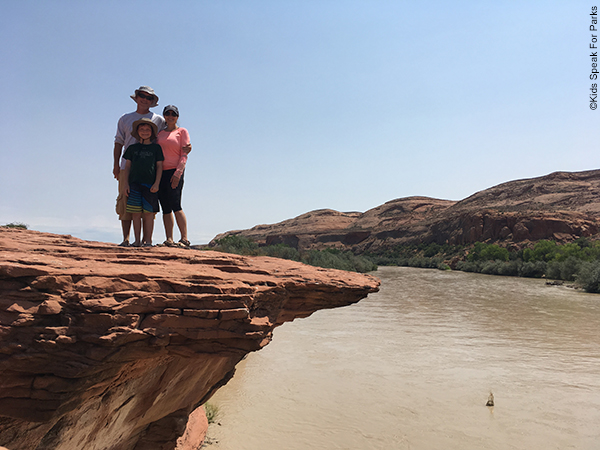
A lot of kids might not have opportunities to get out and visit national parks and monuments like you’re doing. Some kids may think these places have nothing to do with them. How do you get those kids to care?
[Through Kids Speak for Parks] I will be going to schools and talking to kids about how amazing the parks are. I’m going to take kids from a lot of cities to really pretty parks that they have probably never seen before so that they can stand up and speak for the parks. [Note: More information about this initiative will be available on the Kids Speak for Parks web site soon.]
If somebody called you and said, “Robbie, we have Secretary of the Interior Ryan Zinke on the line for you. You have one minute to speak to him.” What would you say?
I would say, “Don’t get rid of the parks. It’s not just business. That’s not America’s purpose. National parks are a big part of America. If you get rid of the National Monuments, people won’t be able to see the wilderness anymore.”
*Editor’s note: To find out where Robbie is today, or to support his efforts, visit on the Kids Speak For Parks Facebook page.
At Bears Ears National Monument, you met a young man named Alejandro Yazzie from the Ute Tribe. What was one of the most important or interesting things that you learned from Alejandro?
Robbie: He told me about his family’s culture, and how his great, great—I forgot how many “greats” it was—granddad actually saw the first white people come there. I knew that there were Native Americans at Bears Ears, but I didn’t know much about them. When I went there, I learned a lot about their culture and how they survived.
Has anyone ever not taken you seriously because you’re a kid?
Robbie: I don’t like to remember those guys, because they’re not very helpful. I just pretend they don’t exist.
What gives you hope for our parks and other places like them in the world?
Robbie: The amount of people who are still trying to protect our parks, and just seeing how much wilderness there is.
A lot of adults (including many of the people who read this publication) have been working hard to protect and improve all kinds of parks—national parks and monuments, state and city parks, and even small community parks. A lot of them might find it easy to lose hope. What advice do you have for them?
Robbie: Don’t give up. You can always find things that will keep you going, like other people and animals. As a last resort, just watch cute puppy videos on the Internet.
Kids are important users of parks, but I bet they are rarely asked to be involved in the planning and design of parks and in park projects. What do you think would happen if more kids were involved in those kinds of projects?
Robbie: I think it would work way better. Adults can’t always appreciate the things that make the parks fun, like the chipmunks that steal your s’mores. These are a lot of little, tiny things that kids appreciate but adults don’t really notice. Adults will look at the bigger picture, like the amount of trees. Children look at the types of trees, and the types of animals that live there. Adults don’t think about that kind of stuff as much as kids do.
A lot of parents out there—myself included—struggle to compete with the draw of electronic devices. I’d like to ask your parents if they have any advice for other parents who are hoping to instill in their children a sense of wonder and stewardship of nature?
Michelle: We’re a bit biased, because we come from Hawaii, where it is easier to get away from electronics. We can go out and actually rescue a sea turtle, which is way more exciting than Minecraft. But for anyone, going outdoors and creating fun family time helps a lot, even if you’re just going somewhere like a small, local park. It is also helpful when kids can see the impact of their choices, like when they see something like rings from soda cans that get caught around a sea turtle’s neck. Even when they see something like that on a YouTube video, it becomes more real. That helps children develop a passion.
A lot of kids might not have opportunities to get out and visit national parks and monuments like you’re doing. Some kids may think these places have nothing to do with them. How do you get those kids to care?
[Through Kids Speak for Parks] I will be going to schools and talking to kids about how amazing the parks are. I’m going to take kids from a lot of cities to really pretty parks that they have probably never seen before so that they can stand up and speak for the parks. [Note: More information about this initiative will be available on the Kids Speak for Parks web site soon.]
If somebody called you and said, “Robbie, we have Secretary of the Interior Ryan Zinke on the line for you. You have one minute to speak to him.” What would you say?
I would say, “Don’t get rid of the parks. It’s not just business. That’s not America’s purpose. National parks are a big part of America. If you get rid of the National Monuments, people won’t be able to see the wilderness anymore.”
*Editor’s note: To find out where Robbie is today, or to support his efforts, visit on the Kids Speak For Parks Facebook page.
